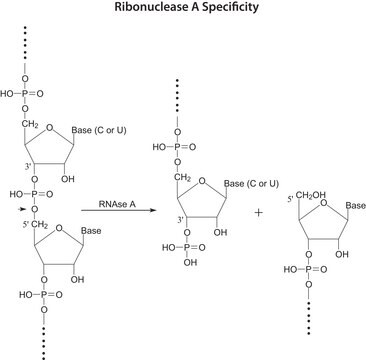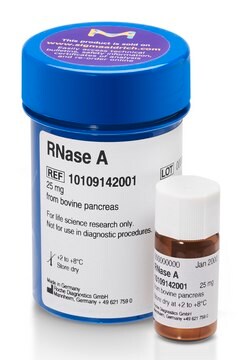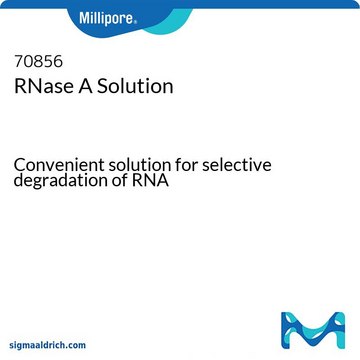R6501
Ribonuclease H from Escherichia coli
recombinant, expressed in E. coli, buffered aqueous glycerol solution, 1,000-4,000 units/mL
Sign Into View Organizational & Contract Pricing
All Photos(1)
About This Item
CAS Number:
MDL number:
UNSPSC Code:
12352204
NACRES:
NA.54
Recommended Products
recombinant
expressed in E. coli
form
buffered aqueous glycerol solution
mol wt
17.6 kDa
packaging
vial of ~30 units
concentration
1,000-4,000 units/mL
shipped in
dry ice
storage temp.
−20°C
Looking for similar products? Visit Product Comparison Guide
Application
Ribonuclease H from Escherichia coli has been used in a study to assess metallobiochemistry of the magnesium ion. Ribonuclease H has also been used in a study to investigate selective inhibitors of HIV-1 reverse transcriptase associated Rnase H activity.
Unit Definition
One unit hydrolyzes 1.0 nanomole RNA in 3H-labeled poly(A) • poly(dT) to acid soluble material in 20 min at 37 °C.
Physical form
Solution in 50% glycerol containing 20 mM Tris-HCl, pH 7.5, 100 mM KCl, 10 mM MgCl2, 0.1 mM EDTA, 0.1 mM DTT and 0.05 mg BSA per ml
Storage Class Code
10 - Combustible liquids
WGK
WGK 2
Flash Point(F)
Not applicable
Flash Point(C)
Not applicable
Choose from one of the most recent versions:
Already Own This Product?
Find documentation for the products that you have recently purchased in the Document Library.
H W Huang et al.
European journal of biochemistry, 219(1-2), 253-260 (1994-01-15)
Ribonuclease H (Escherichia coli) contains one strong magnesium-binding site, as determined by metal-titration experiments monitored by high field 1H-NMR and also by direct titration calorimetry. Kinetic and thermodynamic parameters were evaluated by 25Mg-NMR and were as follows: dissociation constant Kd
Virginie Suchaud et al.
Bioorganic & medicinal chemistry letters, 22(12), 3988-3992 (2012-05-23)
We report herein the synthesis of a series of 3-hydroxyquinolin-2(1H)-one derivatives. Esters and amide groups were introduced at position 4 of the basis scaffold and some modulations of the benzenic moiety were performed. Most compounds presented selective inhibitory properties in
Jessica H Brehm et al.
Clinical infectious diseases : an official publication of the Infectious Diseases Society of America, 55(5), 737-745 (2012-05-24)
It is not known how often mutations in the connection and ribonuclease H domains of reverse transcriptase (RT) emerge with failure of first-line antiretroviral therapy (ART) in subtype C human immunodeficiency virus type 1 (HIV-1) infection and how these mutations
Our team of scientists has experience in all areas of research including Life Science, Material Science, Chemical Synthesis, Chromatography, Analytical and many others.
Contact Technical Service




